Clematis Pros Share 100 Years Of Growing Experience In This Ultimate Guide

CLIMBERS > CLEMATIS

Elizabeth is a Permaculture Garden Designer, Sustainability Consultant and Professional Writer, working as an advocate for positive change. She graduated from the University of St. Andrews with an MA in English and Philosophy and obtained a Diploma in Applied Permaculture Design from the Permaculture Association.
Reviewed By COLIN SKELLY

Colin is a Horticulturist and Horticultural Consultant with experience in a range of practical and managerial roles across heritage, commercial and public horticulture. He holds the Royal Horticultural Society’s Master of Horticulture award and has a particular interest in horticultural ecology and naturalistic planting for habitat and climate resilience.
Contributions From KEN BLACK

Ken is the Membership Secretary of the British Clematis Society and a member of the International Clematis Society, RHS Silver-Medalist, Owner of Ken Black Clematis and star of his own YouTube channel, where he shares knowledge learned over the course of 40 years.

Marcel has been growing and cultivating his own Clematis for more than 30 years; his nursery Floyds Climbers and Clematis release a new Clematis most years, with the most recent being Coconut Ice - a beautiful Tulip-shaped variety.

Peter is the third-generation Owner of specialist nursery Thorncroft Clematis who are 12 x RHS Chelsea Gold Medal winners and known worldwide for their expertise and knowledge in the field of clematis. Peter is also a sought-after public speaker on the topic of clematis and is a guest speaker for The English Garden School at Chelsea Physic Garden in London.

A clematis specialist based in Wiltshire, Fraser has 27 years of horticultural experience. His nursery is a recognised seller of clematis by the RHS and he has a large following on Facebook, where the nursery shares regular updates.

Fiona is the Secretary of the International Clematis Society and a member of the British Clematis Society. She has been growing Clematis for 40 years and even has a Clematis named in her honour!

Janice Shipp is a Writer with 15 years' experience as Principal Researcher for Which? Gardening magazine. She has received her RHS MHort and City and Guilds Planting Design qualifications and is a member of the RHS Herbaceous Plant Committee. Janice is also a member of both the Garden Media Guild and Chartered Institute of Horticulture - and was Chair of forum on a Penstemon trial for the Royal Horticultural Society.
CLEMATIS GUIDES
Clematis is said to be the queen of all climbers – there is clematis available to suit many different spots and a huge array of different options to choose from.
Learn more about these climbers and how to grow them in this guide.
For this guide we interviewed FIVE professionals with over 100 years of Clematis growing experience between them! Our experts include:
- Ken Black – Membership Secretary of the British Clematis Society and a member of the International Clematis Society.
- Marcel Floyd – Owner of Floyds Climbers and Clematis.
- Peter Skeggs-Gooch – Owner of specialist nursery Thorncroft Clematis.
- Fraser Wescott – Owner of Walled Garden Nursery, a clematis specialist.
- Fiona Woolfenden – Secretary of the International Clematis Society.
We feel privileged to have been able to learn so much from these four specialists – and we’re excited to share what we learned below.
“What I love about clematis plants is that they come in all shapes and sizes, from little nodding bells to large saucer-shaped flowers in a myriad of colours,” says Marcel.
Overview
| Botanical Name | Clematis |
| Plant Type | Climber |
| Native Area | Asia |
| Hardiness Rating | H5/6 |
| Foliage | Various |
| Flowers | Various |
| When To Plant | March-April or September-October |
| When To Prune | Varies based on cultivar (usually after flowering) |
Sunlight
Preferred
Full Sun or Partial Shade
Exposure
Exposed or Sheltered
Size
Height
1.5 – 2.5M
Spread
1 – 1.5M
Bloom Time
All year round (depending on variety)
Soil
Preferred
Most fertile soils
Moisture
Moist but well-drained
pH
Alkaline to neutral
Clematis, a genus within the Ranunculaceae family, has nearly 400 different species, and many garden hybrids have been developed from these species.1Clematis. (n.d.-c). Plants of the World Online. Retrieved May 9, 2023, from https://powo.science.kew.org/taxon/urn:lsid:ipni.org:names:329401-2#children
This cultivation has produced a huge range of options for gardeners, and there are now clematis with huge variations which suit a range of different conditions.
“Clematis is the most versatile genus I know,” argues Ken Black.
“By selecting varieties from different groups, they will extend [their] range of colour and height to any garden and provide flowers throughout the year, even in the depths of winter.”
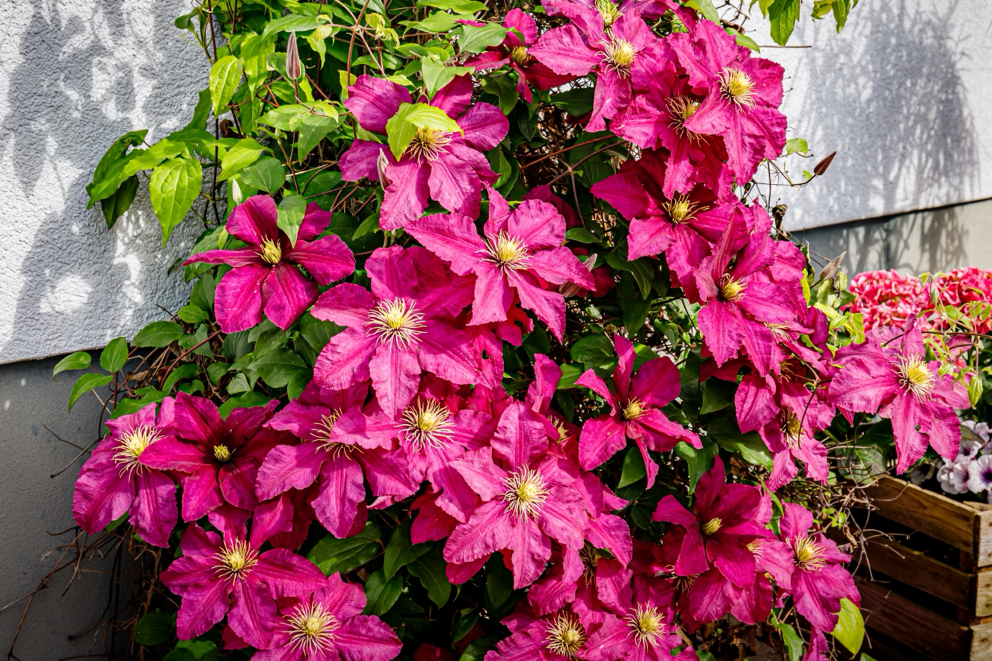
Clematis has become prized for its ability to scramble up walls, fences, trellis and other support structures, and many are well-known ornamental plants.
The horticultural classification of clematis is a complicated thing.
But generally, clematis is divided into small-flowered groups, and both early and late large-flowered groups.
“This is a genus that has varieties growing to only a few inches or monsters attaining 20-30 feet in a season,” says Fraser.
“There is a clematis for all seasons and all situations.”
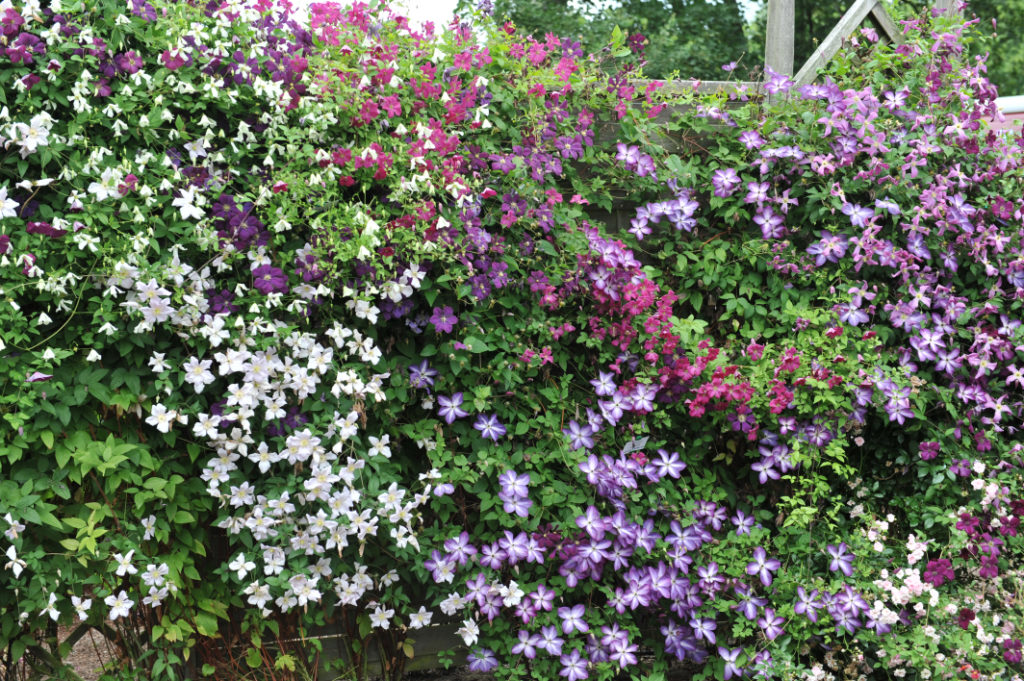
The large-flowered groups are extremely popular in gardens.
These are mostly believed to be hybrids involving crosses of C. lanuginosa, C. patens and C. viticella.
Common Varieties
“There are so many clematis varieties that there’s something for almost every place you can think of in the garden,” says Peter Skeggs-Gooch.
“Their versatile nature and abundance of colours mean we have a lot of options when it comes to fulfilling our gardening needs.”
More than 80 different clematis varieties have gained the RHS Award of Garden Merit.
Here are some common varieties to consider which have received this accolade:
Small-Flowered Clematis
- ‘Abundance’ (Viticella)
- ‘Arabella’ (Integrifolia)
- ‘Bill MacKenzie’ (Tangutica)
- C. montana var. grandiflora
- ‘Constance’
- ‘Elizabeth’
- ‘Etoile violette’
- ‘Freckles’
- ‘Markham’s Pink’
- ‘Tetrarose’
Early Large-Flowered Clematis
- ‘Daniel Deronda’
- ‘Fujimusume’
- ‘Ken Donson’
- ‘Marie Boisselot’
- ‘Mrs Cholmondeley’
- ‘Mrs George Jackman’
- ‘Nelly Moser’
- ‘Niobe’
- ‘The President’
- ‘Wesselton’
Late Large-Flowered Clematis
- ‘Blekitny Aniol’
- ‘Comtesse de Bouchard’
- ‘Ernest Markham’
- ‘Gillian Blades’
- ‘Gipsy Queen’
- ‘Jackmanii’
- ‘Jacqueline du Pre’
- ‘Polish Spirit’
- ‘Prince Charles’
- ‘Zohapbi’
“The plant I couldn’t live without would have to be my Clematis ‘Wisley’,” shares Janice Shipp, Garden Writer.
“It’s a beauty and every year I’m amazed by how big it gets and how many flowers it has. I can sit on my rocking bench and admire it for weeks on end and I would really miss it if it wasn’t there.”
For those just starting out with growing clematis, Peter has some apt suggestions:
“There is one group of clematis that are very forgiving and excellent for beginners…”
“They are called the ‘Viticella’ and they are late summer flowering and very prolific in the quantity of flowers they produce, they also require less attention than many clematis because of their natural vigour.
Ken Black agrees:
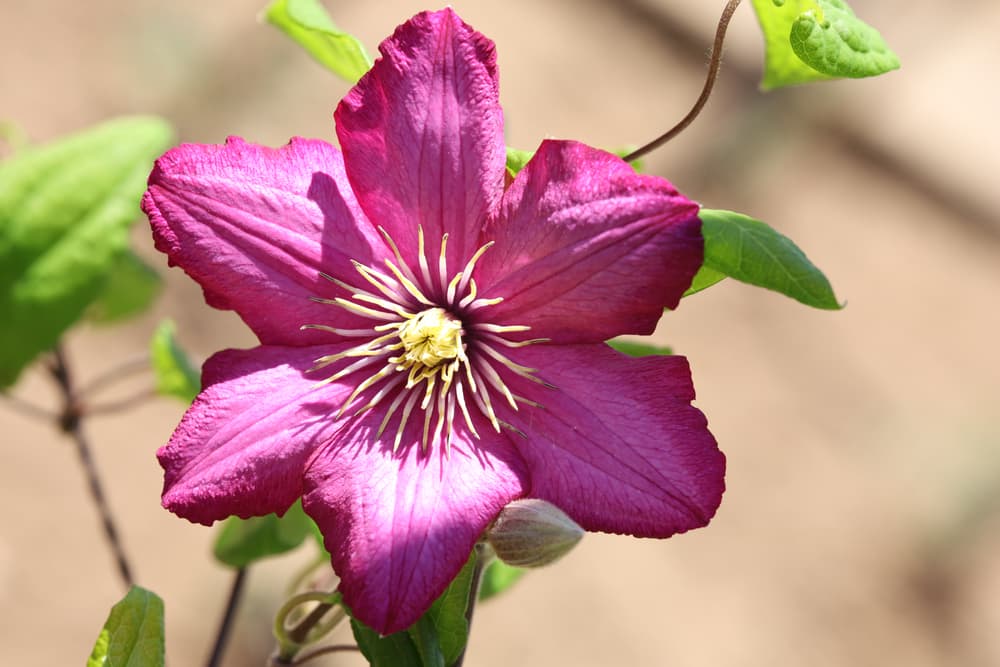
“Viticellas can be planted in a variety of garden situations and they come in many different shades, size and shape of flower.
“They are fairly disease resistant and when hard pruned each spring, down to about 3 feet, will provide an abundance of flowers.”
“Viticella group Clematis are a firm favourite of mine in the garden,” says Horticulturist Colin Skelly.
“The first Clematis I ever grew was ‘Etoile violette’ and it is still going strong despite being moved a few times.
“Once established, they are simple to grow and prune and give plenty of floral rewards with minimal effort.”
Planting Clematis
“Clematis are often portrayed as all having the same habits and growing needs, but this is not true,” says Ken Black.
“They originate from many parts of the world largely, though not exclusively, from the northern hemisphere.
“Access to information about what conditions are best suited to each group is therefore important if you want to get the best out of this wonderful range of plants.”
Most Clematis will grow best in a sunny or partly shaded spot and will not flower as well in a deeply shaded location.
The idea is usually to keep the roots cool and moist, so a position which allows for light shade at ground level but provides plenty of sun for the growing plant is usually ideal.
However, there are cultivars which can be chosen to suit any spot, be it a shady wall, or one that is particularly bright and sunny.
Herbaceous types usually require a position in full sun, and some clematis, including winter and spring flowering types, need a sheltered position since they are not so hardy.
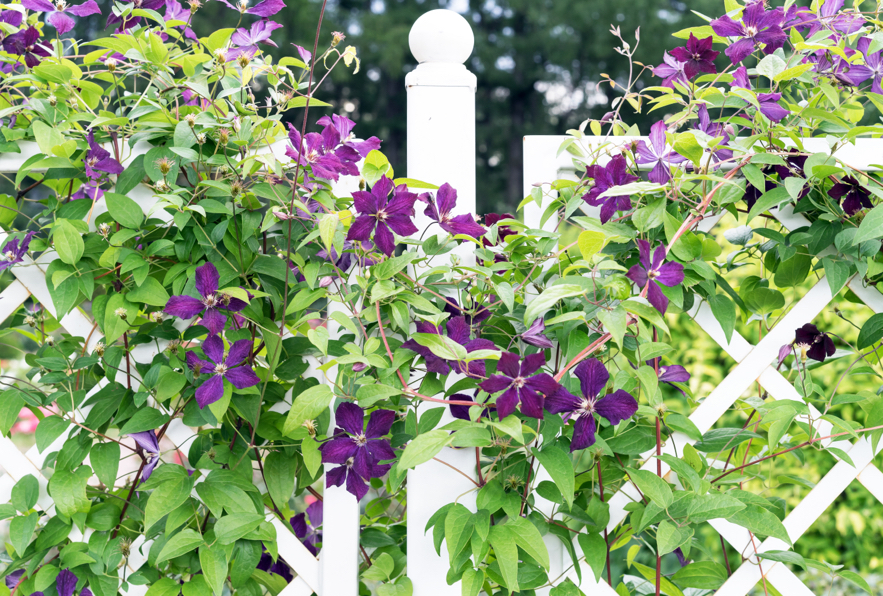
Of course, climbers like clematis will need some kind of support, be it other plants, a free-standing trellis or other structure, or a support structure on a wall or fence.
It is important to think about how you will support your clematis before you decide where exactly to place it.
We’ll discuss your options for supporting climbers like clematis a little later in this guide.
Many clematis also work well in containers.
How To Plant
The first stage in planting clematis is preparing your planting area and supporting structures.
You need to be aware of the growing requirements of your clematis (covered below).
“A good depth is required to accommodate a couple of forks full of rotted compost or manure and to allow the root ball of the clematis to be planted about 2-3 inches deeper than the original level in its pot,” explains Peter from Thorncroft Clematis.
Clematis is planted somewhat differently depending on what type you are growing.

Large-flowered types are planted with the top of the rootball 5-7.5cm below the surface of the soil.
This can be beneficial in allowing the plant to recover if infected with clematis wilt and it encourages the growth of new shoots from below ground level.
Other clematis types are planted with the top of the rootball only just below the surface of the soil.
Whichever type of clematis you are planting, it is important to make sure, when planting close to a wall or fence, that the planting hole is beyond the rain shadow of the structure, as Ken Black explains:
“When planting a clematis to grow up a wall, don’t plant it too close to the structure because the base of the wall will be dry and the clematis will not receive enough moisture. Plant it at least 3 feet away.”
If you are planting clematis to climb a tree or shrub, it is best to plant it on the side from which winds most frequently approach.
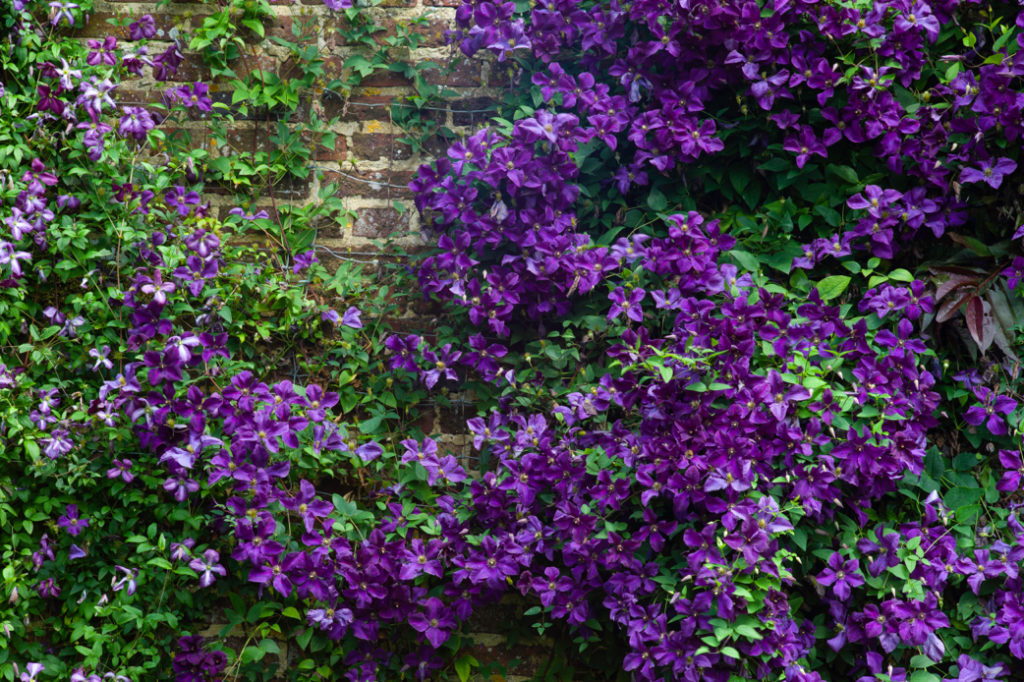
That way, the climber’s stems will be blown towards the trunk or branches rather than away from them.
Clematis should usually be placed at least 1.2m away from the base of the supporting plant to avoid excessive competition for nutrients and water.
When growing clematis in pots, remember to think about support and make sure that if the support is in the container, the container is large and heavy enough that it will not be knocked or blown over.
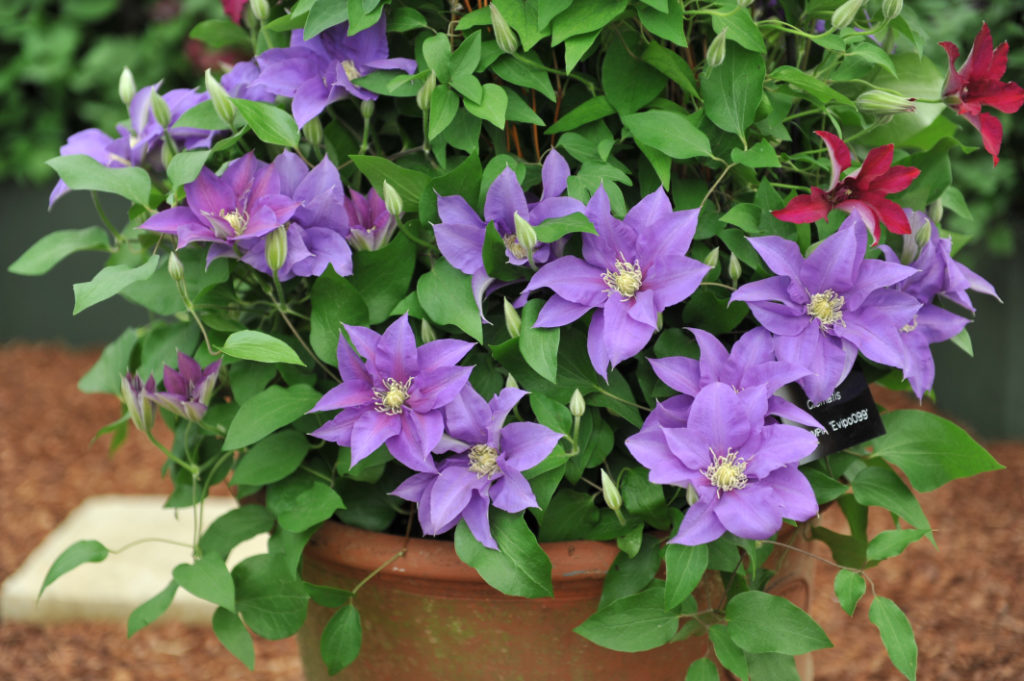
Any clematis containers should be at least 45cm in depth and width.
Plant your clematis in the container with a peat-free, soil-based potting compost.
Ongoing Clematis Care
Soil Conditions
Clematis can tolerate a wide variety of soils and soil conditions, but they will tend to thrive most when planted in a deep, fertile, and moist but free-draining soil or medium.
“There are a lot of clematis varieties with fine root systems, and they can be prone to ‘wetting off’ in the winter,” explains Peter.
“Soil drainage can also be important for certain cultivars, so you should pay close attention to the root system when you take the pot off and, if the roots are very fine and fibrous, then free-draining conditions will be preferred.”
If your soil is not optimal (if it is heavy clay, for example) or very light and sandy, adding plenty of organic matter prior to planting will help yield better results.
Light Requirements
Clematis will vary in their light requirements.
As mentioned above, some are better in sun and some in partial shade, though flowering will always tend to be diminished in deep shade.
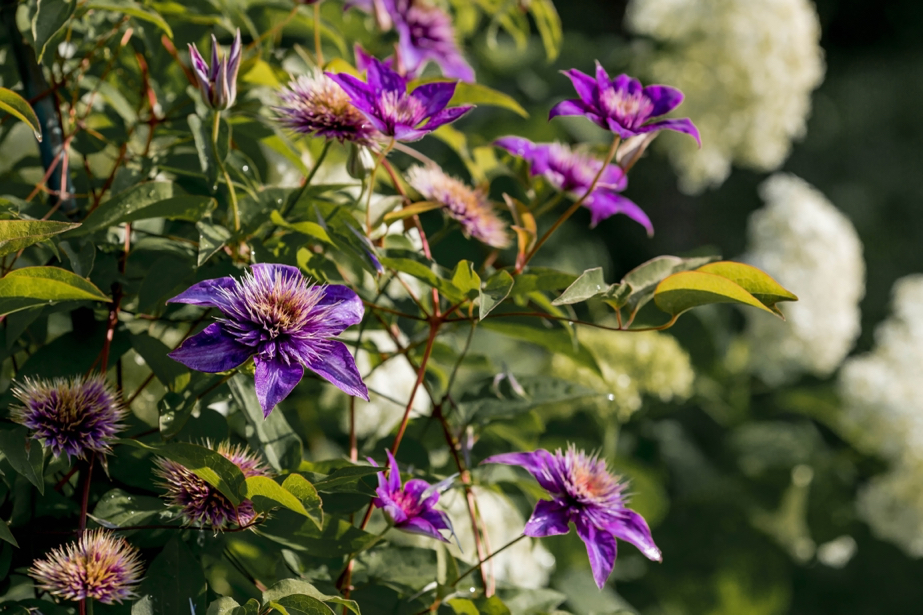
As a general rule of thumb, remember that it is usually best to keep the roots in light shade and allow the plants to grow in full sun.
This is important when growing in containers as well as growing in the ground, so add other low-growing companion plants around the base or add mulches to keep the roots cool.
Watering
Clematis tend to be rather fussy about soil moisture and will suffer if the soil or growing medium is allowed to dry out.
Make sure that you water well, especially during dry periods until plants are well established.
Remember that clematis growing in containers will need to be watered more frequently than those growing in the ground.
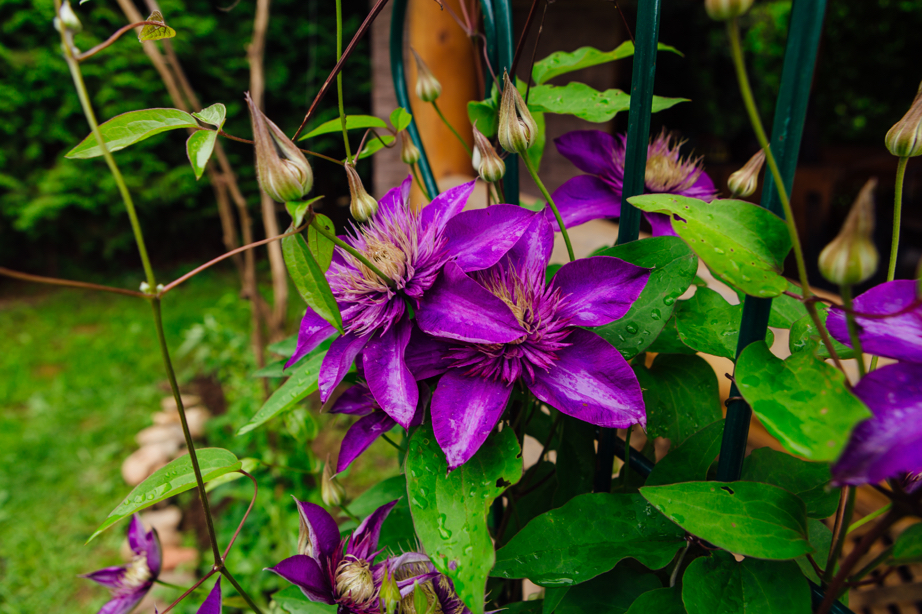
When watering clematis, make sure that you give the plants a deep soaking.
The soil or growing medium should be thoroughly soaked to around 30cm in depth.
For plants growing in the ground, this might represent at least four watering cans worth of water per square metre.
Thinking about how you will harvest rainwater to meet watering needs is a very good idea when growing these thirsty plants.
Temperature & Humidity
Clematis vary in their temperature requirements as some are hardier than others.
However, most clematis plants will appreciate a warm and sheltered spot, with relatively high humidity, especially around the base of the plants.
Mulching For Cool Roots
Marcel from Floyd’s Climber & Clematis thinks that creating shade at the base of clematis’ roots is one of the most important care factors, as this helps to keep the roots cool.
Mulching is one way to do this.
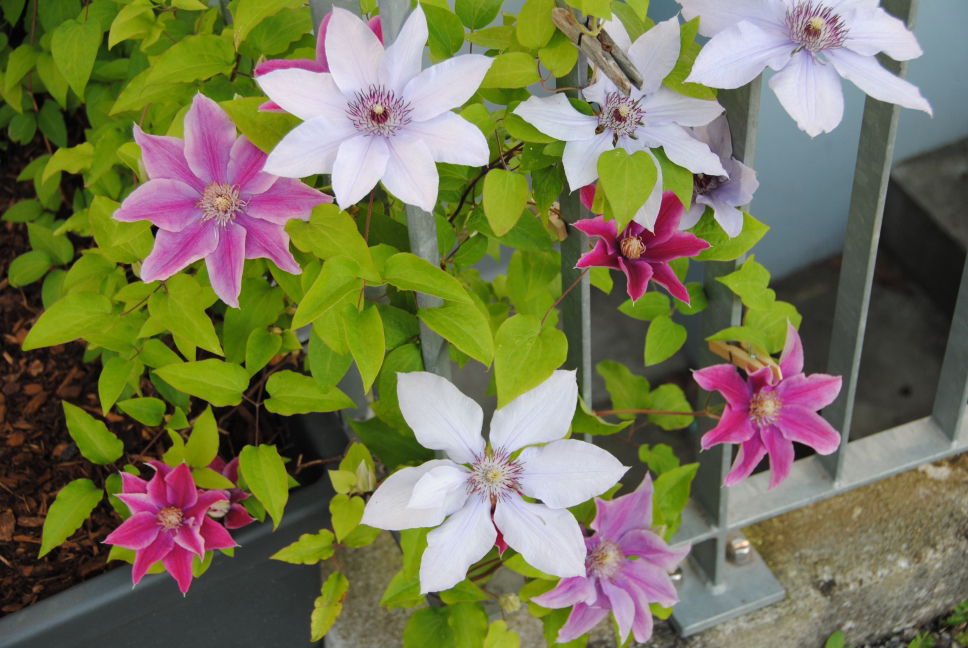
A garden compost, well-rotted manure, or leaf mould can be ideal, since these will not only keep roots cool and help conserve moisture but will also provide slow-release nutrients to the plants.
Fertilising
In addition to adding organic mulch around the base of the clematis for fertility, it is also a good idea to add a potassium-rich organic fertiliser around the base of the plant in early spring each year to encourage good flowering, as Ken explains:
“Feeding is optional, but the quality and number of flowers can be improved by providing additional nutrition.”
Container-grown clematis should also be fed with a multi-purpose organic liquid feed during the spring and summer around once a month.
Supporting
Support is important for clematis plants and choosing the right option can help you achieve the best and most pleasing results.
There are many options which are both practical and aesthetically appealing.
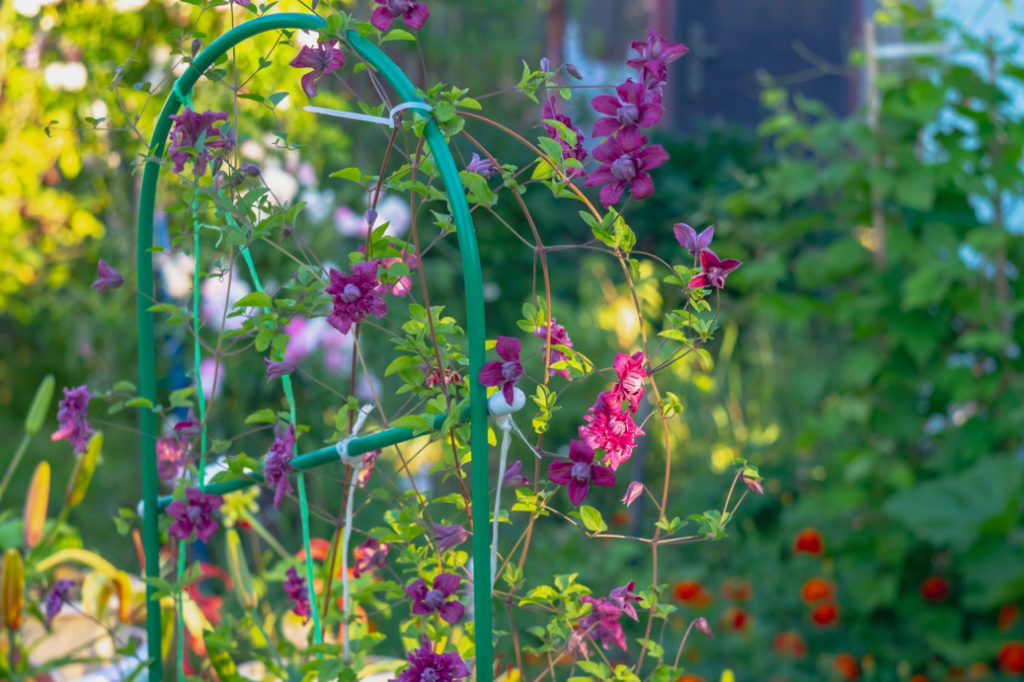
For example, you might grow clematis:
- Up an existing tree or shrub
- Against a wall or fence
- On a wall, fence-mounted, or free-standing trellis
- Over an archway, arbour, pergola or other garden structure
- Up a pillar or obelisk
Some climbing clematis can twine naturally around their supports, but it is a good idea to carefully tie in the stems to your support to make sure they are secure and spread out more evenly over the structure and flower better.
Use natural twine and secure the stems using a loose figure of eight knots.
Pruning
Different types of clematis require different pruning care, as Ken reminds us:
“Each year I am invited to talk with garden clubs and one of the most common issues raised is pruning. This is not a difficult subject if you know the name of a clematis.
“Too often, however, the plant label has been lost and the name is forgotten.”
Vigorous growers and early-flowering species generally need no pruning at all, though occasionally tangled growth may need to be thinned or removed.
Early flowering large-flowered clematis types are generally pruned lightly in the dormant period to improve their structure.
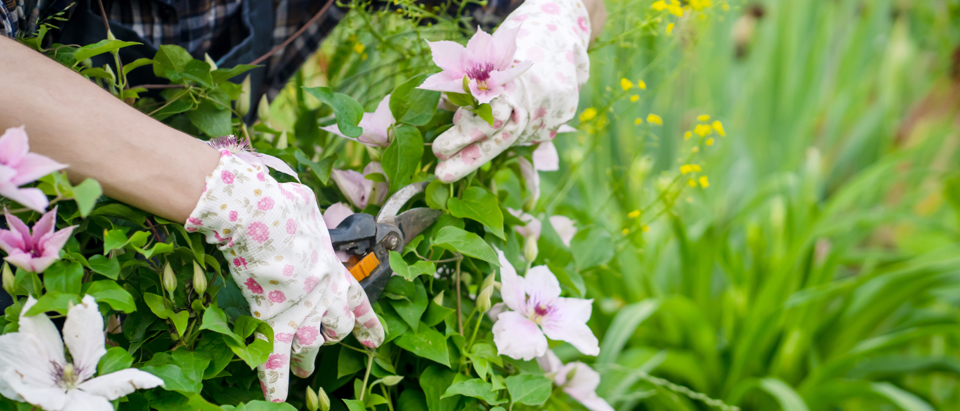
Late-flowering large-flowered clematis is also usually pruned during the dormant period, and the current season’s growth is generally pruned back to a pair of buds.
If you are unsure about which pruning group your clematis falls into, you can follow this simple rule: If clematis bloom before June, do not prune.
“By remembering this, you are not going to cut off the buds of a clematis that is about to flower early in the year and has formed its buds before becoming dormant for the winter,” explains Ken.
“Any clematis that should flower from June onwards will still do so even if you might have been more heavy-handed than you need to have been.”
If they bloom later, prune in late winter (I find that February is the best month to do so).
Propagation
Clematis can be propagated from semi-ripe cuttings taken between spring and late summer.
In warm and humid conditions they should usually root within a couple of months.
These cuttings should be potted up into individual pots the following spring and should flower within two years.

Clematis with long, flexible stems can also be propagated by layering (looping stems below the soil to encourage new roots to form on the buried sections).
After 1-2 years, new roots should have formed and the stems can be severed from the parent.
References
- 1Clematis. (n.d.-c). Plants of the World Online. Retrieved May 9, 2023, from https://powo.science.kew.org/taxon/urn:lsid:ipni.org:names:329401-2#children
